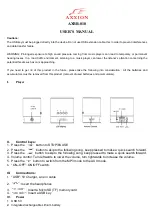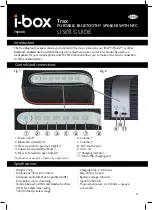
2.) Using Loop-Through Terminals (Pins 2 & 3 on Control
227C, Pins A & B on Control 226C/T) -- By connecting
the wire pair of the subsequent speaker to pins 2 & 3 on
the Control 227C and Pins A & B on Control 226C/T, then
all subsequent speakers will be disconnected when this
speaker’s connector is disconnected during troubleshooting .
This can be useful as a way to isolate problems to a section
of the distributed line while leaving the wires attached to the
connector.
WIRING INSTRUCTIONS, CON’T
Figure D:
Loop-Through System
Hookup Diagram
Power Amp
+
-
1 2 3 4
Speaker 1
1 2 3 4
Speaker 3
1 2 3 4
Speaker 2
+
-
From Amplifier or
Previous Speaker
To Subsequent
Speakers
+
IN
1
2
-
Loop
Thru
+
-
+
3
4
-
IN
Loop
Thru
+
-
Figure A:
Paralleling Input Terminals
From Amplifier or
Previous Speaker
+
IN
1
2
-
Loop
Thru
+
-
+
3
4
-
IN
Loop
Thru
+
-
Figure C:
Using Loop-
Through Terminals
To Subsequent
Speakers
Control 227C
+
IN
1
2
-
IN
+
A
-
Loop
Thru
B
Loop
Thru
+
-
+
-
Control 226C/T
From Amplifier or
Previous Speaker
To Subsequent
Speakers
On the Control 227CT, connect the negative input to the
“Common” terminal and connect the positive input to the
appropriate tap.
For example, if the system is being driven
from a 70V Distributed Line and the 30W tap is desired, the
positive input would be made to the input marked 30W and
the negative connection would be made to the “Common”
pin.
The input pins correspond to the taps of the transformer
indicated on the label below each connector.
Guide to Connection Pins on Control 227C -- The
removable locking input connector contains 4 terminals, as
marked on the connector. The pin functions are listed on the
label located on the crossover frame.
Pins 1 & 4 are the “+” and “-” inputs to the loudspeaker.
Connect the negative wire to “-” or pin 4 and connect the
positive wire to “+” or pin 1. Pins 1 & 4 are looped to pins 2 &
3, respectively (Pin 1 connects to Pin 2 and Pin 3 connects
to Pin 4) inside the speaker. Pins 2 & 3 are intended as loop-
through connections to subsequent loudspeakers. There are
two possible hookup schemes for connecting subsequent
speakers, determined by the desired result from the circuit
whenever this speaker’s connector gets disconnected during
troubleshooting.
Hookup Schemes for Subsequent Speakers
Choose whichever of the following hookup patterns best
accommodates your installation.
1.) Paralleling Input Terminals -- Connect the wire pair of
the subsequent speaker to pins 1 & 4 (in parallel with the
input wire pair). Whenever the connector is pulled out of the
speaker for troubleshooting, subsequent speakers will stay
connected. This can be useful during troubleshooting to be
able to disconnect a single loudspeaker at a time. In this
hookup scheme, no wires get connected to pins 2 & 3.
+
-
1
4
3
2
Loop
Thru
IN
IN
+
-
Loop
Thru
CONNECTION
Control 227C:
Figure B:
Parallel System
Hookup Diagram
Power Amp
+
-
1 2 3 4
Speaker 1
1 2 3 4
Speaker 3
1 2 3 4
Speaker 2
+
-
6 JBL Professional Control 200 Series






























